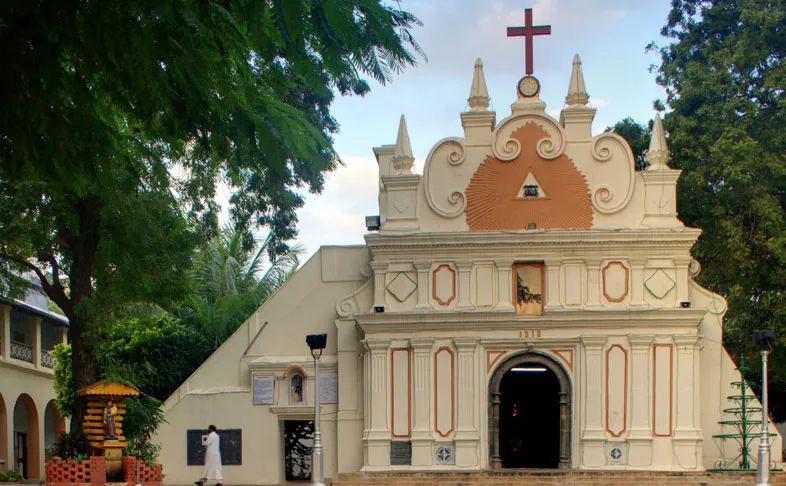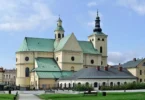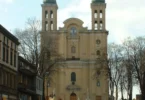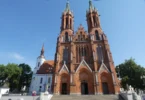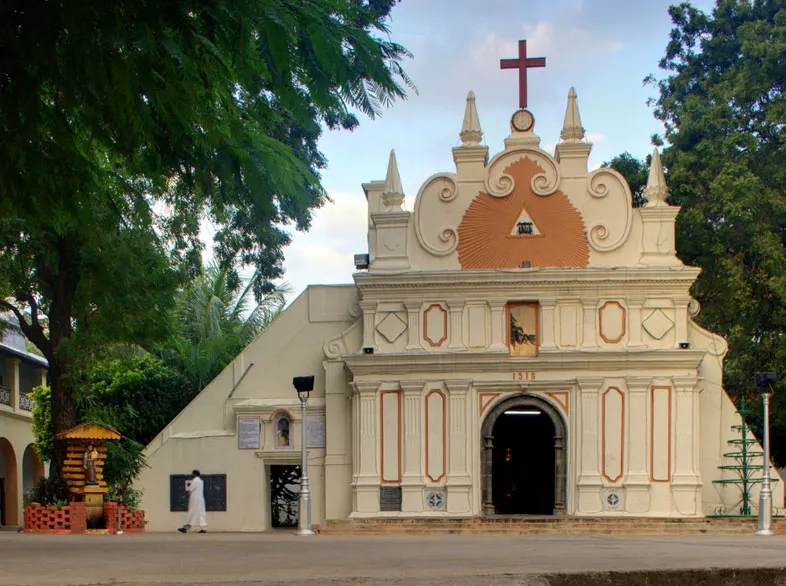
Introduction
Our Lady of Light Shrine, Chennai (Tamil: பிரகாச மாதா ஆலயம்) is a Roman Catholic shrine in Chennai, India. It is commonly called as Luz Church by the locals, which derives from the Portuguese name Nossa Senhora da Luz.
Luz Church of Our Lady of Light Shrine, Chennai is one of the oldest churches situated in the Mylapore region of Chennai and named after the Portuguese, Nossa Senhora Da Luz. The foundation stone indicates that it is one of the oldest European monuments of the country. The gracious complex was constructed in 1516 when the area was surrounded by thick forest due to which it was named as Kattu Koil or Forest Shrine. Kattu means forest and Kovil means place of worship in Tamil.
Built in 1516 by the Portuguese, it is one of the oldest Churches in the city and its foundation stone marks as one of the oldest European monuments in India. The history of the church dates back to the 16th-century legend of safe arrival to land by missionaries. The church is located very near to the Santhome Basilica, where Apostle Thomas is believed to be buried.
Term Luz means light in Portuguese. Legends state that in 1500 A.D. eight Franciscan Portuguese priests on their way to India from Lisbon got lost in the sea. They worshipped Virgin Mary for help and were guided by a bright light that led them safely to a forest area.
Father Pedro da Atougia, the Franciscan friar then built a church in honour of Mother Mary at the same spot where the miraculous light led the priests to safety and called it as Nossa Senhora Da Luz. Nossa Senhora means Our Lady and Luz means light. Henceforth it was renowned as the Church of Our Lady of Light. A gracious structure with white facade and fringes of blue is a charming place of visit.
Our Lady of Light Shrine, Chennai has undergone several renovations post the damages caused by the Golcanda Muslim forces and Mysore Haider Ali. Archbishop A. M. Chinnappa, declared the Church of Our Lady of Light as the Shrine of Our Lady of Light on 15th of August 2010. It governs the Stella Maris College in Chennai.
If you are looking to explore Luz Church of Our Lady of Light along with other key attractions of the city in a day then hop on our exciting one day Chennai tour packages or customize your own tour with your preferred list of tourists places in Chennai.
Although at the time the church was built, the locality was a thick forest, now it is part of a bustling metropolitan area. This 16th-century European-architecture building consists of patterns of Gothic arches and Baroque ornamentation. The feast of Our Lady of Light is celebrated on 15 August every year.
The historical background of this church is intertwined with the traditional history of Christianity in India. Arrival of Christianity to India is of two phases, where by traditional accounts, St. Thomas brought the religion in the first century and attained martyrdom in Chennai in AD 53. The second phase is after the arrival of Portuguese in the 15th century. The legends of the Church of Our Lady of Light connects both.
History of Our Lady of Light Shrine, Chennai
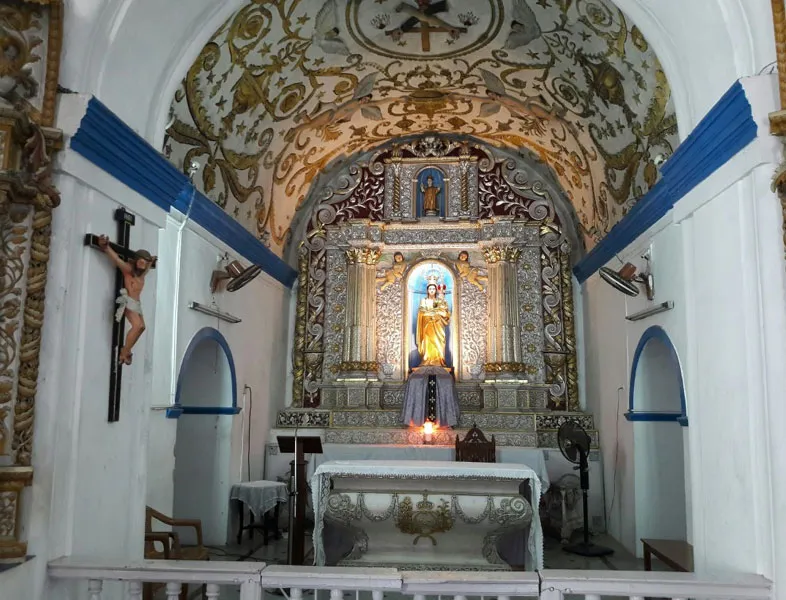
The history of Our Lady of Light Shrine, Chennai is compounded with the history of the arrival of the Portuguese to India. Soon after Vasco da Gama discovered the sea-route to India, the legend states, that eight Franciscan priests left for India from Lisbon with the fleet of Pedro Alvares Cabral on 9 March 1500. They landed in Calicut, where three of the Friars were slain on 16 November 1500. The others reached Cochin, and settled down of preach the good news.
A few years later, they sailed down South to spread their message further. It is said, that the Friars were lost in the rough sea and started praying to Mother Mary for their safety. The legend states that they were miraculously guided by a mysterious bright light which guided them safe to land. The Friars that in honour of their safe arrival to the land, built the Church of Our Lady of Light (Portuguese: Nossa Senhora da Luz).
Our Lady of Light Shrine, Chennai would later suffer damages inflicted from the forces of Golconda between 1662 and 1673. During the times of Haider Ali’s invasion of the city forts between 1780 and 1782, the British East India Company Forces occupied the Luz Parish Residence for some years. Currently this church also governs the Stella Maris College, Chennai.
Our Lady of Light Shrine, Chennai is located in Mylapore local of Chennai and at the time it was built, this part of Mylapore is believed to have been a thick forest. Thus the church gets its local name in Tamil as “Kaatu Kovil” (Tamil: காட்டுக் கோவில்) (Jungle Temple).
It is located about 1.5 km from the Santhome Basilica where Apostle of Jesus Saint Thomas is buried. Although now a bustling locale, it is believed that this area could have been covered with mangroves in the early days. The road leading to the church is now named as Luz Church road after the church itself.
The existing structure at Luz was built by the Portuguese in 1516. The architecture of the building consists of patterns of Gothic arches, Baroque ornamentation compounded with classical European style. The altars are gilded with silver and gold leaves and the ceilings with powder blue fresco paintings.
The building plan resembles the Portuguese style in more than one way. Luz church represents one of the many attempts made by these people to leave their identity in far-off places. The foundation stone of this church is considered to be one of the oldest European monuments in India.
Architecture of Our Lady of Light Shrine, Chennai
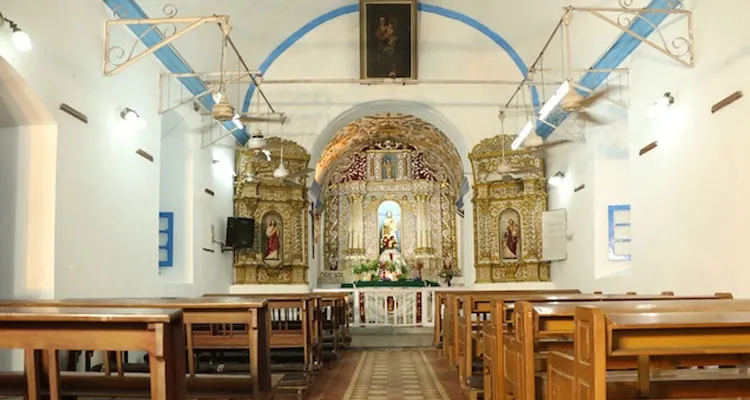
Our Lady of Light Shrine, Chennai – Built in Gothic style of architecture, this meticulously decorated church is a must visit to explore its Baroque ornamentation and astounding arches. Altar stands majestically decorated with silver and gold leaves and the ceilings are adorned with amazing paintings.
Imposing statues of Christ and St Joseph set on to the right and left of the sanctuary add charm to the Church. A noteworthy feature is the picture of Mother Mary with her child Jesus in her arms on the side wall. Outside the Church is a tall statue of one of the apostles of Christ, St. Jude.
Our Lady of Light
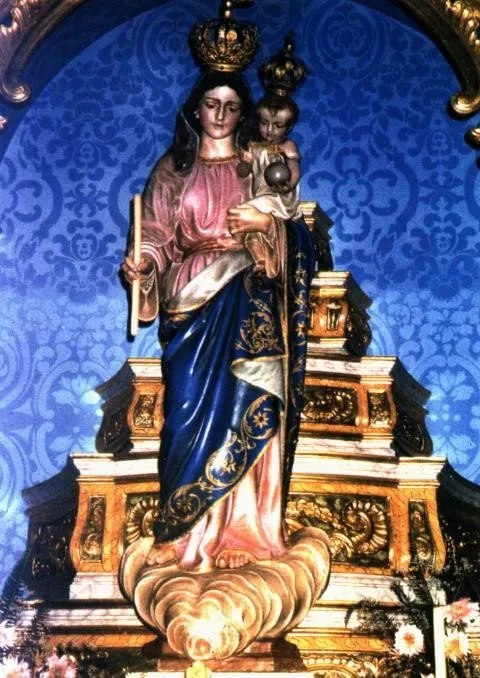
Father Giovanni Antonio Genovesi, SJ was born in Sicily on March 4, 1684, and became a novice of the Compania de Jesus (Society of Jesus/Jesuits) on March 2, 1703. As a missionary, he went around Sicily for twenty years. Through his preaching, he was able to bring people to Jesus through the Blessed Virgin Mary, whom he would always call upon for guidance in his missionary work.
The last part of his life served as a fitting culmination of his life of service. Father Genovesi was then the superior of the novices and the rector of the college in Messina when a fatal plague broke out in 1743. The college was turned into a hospital where the Jesuits untiringly served those who were stricken by the plague. As time went on, the novices were inflicted by the plague one by one. On July 6, 1743, Father Genovesi died after being struck by the plague.
During the first quarter of the eighteenth century (1722), Father Genovesi desired to have a representation of the Virgin Mary painted to take with him and display as he preached missions throughout the island of Sicily.
He asked the help of a devout lady in a neighboring village who had the reputation of having frequent visitations from the Virgin Mary and asked her to request guidance. The Virgin Mary granted the request and she described exactly how she wished to be represented. She showed herself to the lady in the Church of S. Stanislao al Noviziato.
The Virgin appeared in a glorious light, surrounded by a host of seraphim and was extremely beautiful. She wore an imperial crown and had a girdle adorned with jewels that surpassed the beauty of the stars. On her shoulders was a blue mantle. On her left arm, she carried the Child Jesus.
With her right hand, she lifted a sinful soul from the horrible throat of Hell, keeping it from falling back in. On the other side, a kneeling angel held up a basket filled with hearts, which he presented to the Divine Child in His mother’s arms. He took the hearts one at a time and inflamed them with his love. The Virgin Mary said she wished to be called Maria Madre Santissima del Lume (Mary Most Holy Mother of Light), and repeated it three times, and said not to forget that.
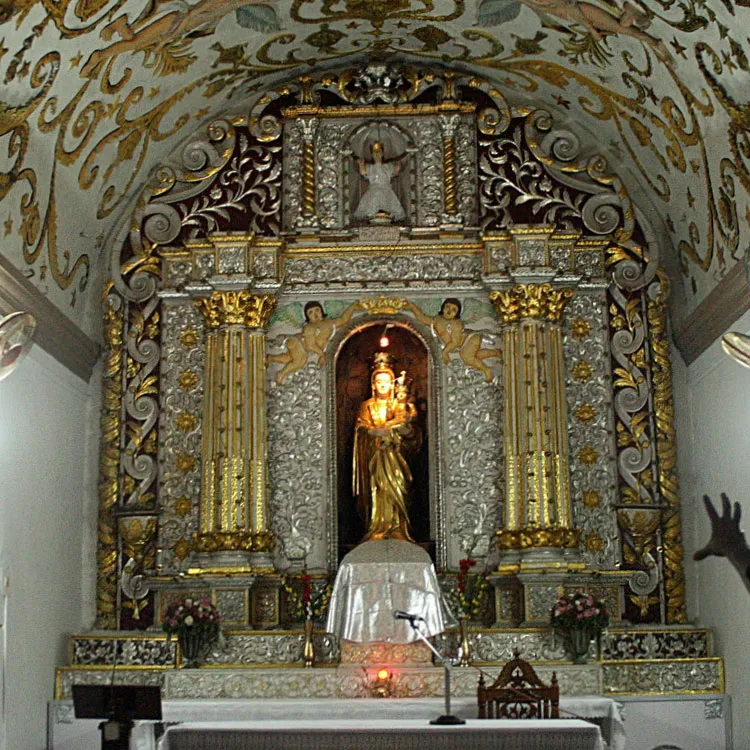
The pious lady returned to Father Genovesi and recounted all that the Virgin had said, and he quickly found a painter and gave him the instructions. The lady did not go to the painter’s studio out of modesty, the priest did not supervise the work, and the result was not satisfactory. The choir of angels was lacking, there was a crescent moon beneath her feet, and her robe was red rather than white. As a result, the Virgin Mary did not give a promised sign of approval.
Father Genovesi asked the woman to go to the painter, but she was extremely busy with family matters in Bagheria, which is some distance from Palermo, and couldn’t get away. The Virgin, however, appeared to her again and said she needed her in Palermo. The woman, in turn, protested that since the Virgin had all the resources of Paradise, how could such a vile worm as she carry out such an important task, and, anyway, there was no way she could get away.
The Virgin responded that whether or not she felt she could go to Palermo she would, in no uncertain terms. As a result, the woman was hit with a terrible pain in her chest and lost her voice. There seemed to be no cure, and she was taken to Palermo where the air was more temperate and healthy. In fact, after she arrived she was soon healed.
Once the woman was in Palermo, and healed, she was visited again by the Virgin. The lady said both she and the priest were very disappointed that the painting didn’t turn out right and asked if a new one should be made. The Virgin responded positively, and this notice was taken to Father Genovesi who arranged for a new painting to be done. It was the custom of the Virgin to send a guardian angel to her “servant” the evening before to warn that she would appear after the woman had received communion.
The woman, following instructions, then went to the painter’s studio where she found him ready to begin work. The Virgin had said that she would meet her there, but only she would have the vision.
The woman was to instruct the painter, but the Virgin would guide his brush. This in fact, happened, and the work was accomplished to the satisfaction of the Virgin. Although numerous copies were subsequently made, none approached the perfection of the original. Even the painter himself could not duplicate exactly his first work.
The picture of the Madre Santissima del Lume was always carried by Father Genovesi in his mission. Each time the people of a certain place would know that he and the picture were coming, they would wholeheartedly prepare their chapel or church, and the altar on which the holy picture will be enshrined.
The arrival of the priest and the picture was always met by many people holding flowers or lighted candles. According to tradition, the visitation of the picture would always result in great love and devotion to the Virgin, thereby making it very difficult for the people to part with the picture. This started the practice of leaving a faithful copy of the picture in the chapel or church of the place visited by Father Genovesi.
History of Our Lady of Light
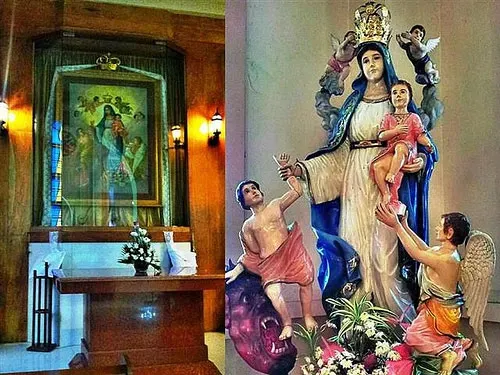
The devotion to Our Lady rapidly spread to the community of the faithful in Noviziato al Capo, where in 1736 a group was formed which became the Confratemita della Madonna del Lume al Noviziato. On February 6, 1736, Pope Clement XII authorized through an apostolic letter the veneration of the Virgin Mary under this title.
Moreover with the same document, the feast of the Virgin was established on the Second Sunday of September, and a plenary indulgence was granted to those who will participate in the Mass on the feast day. In Palermo, the Virgin is the patroness of carpenters, while in Porticello, also in Sicily, she is the patroness of fishermen. It is unfortunate that the original picture painted in 1722 was destroyed with the church of Casa Professa when it suffered bombardment during the war in 1943.
A few years after the birth of the devotion to the Mother of Light in Palermo, the devotion was introduced in Cainta (Philippines) by the Jesuits in 1727. The Jesuit missionary ministering in Cainta during that time, Father Bartolommeo Cavanti (al Gavanti), SJ, may have been instrumental in introducing the devotion, since he came from Ferrara, Italy.
The devotion to Our Lady in Cainta preceded by some years the same devotion introduced by the Jesuits in Guanajuato, Mexico (1732); Loon, Bohol (1753); and to the Nuestra Senora de Salvacion introduced by the Franciscans in Horoan, Tiwi, Albay (1776). The devotion also spread in Italy, Ecuador, Venezuela, and Peru. Since then, Our Lady has been called by various titles, e.g. Nuestra Senora de la Luz/Lumen, Our Lady of Light, Kabanal-banalang Ina ng Kaliwanagan, or Inang Santisima ng Kaliwanagan.
The holy picture of the Our Lady of Light brought by the Jesuits has a gilded frame and crest, and was enshrined in one of the colaterales (side altars) of the church of Cainta. Before 1853, the holy picture was transferred to the retablo mayor (main altar). Above it was the image of St. Andrew the Apostle, the patron principal, and on both sides were the images of St. Anthony of Padua, and St. Aloysius Gonzaga. Unfortunately, the original picture of Our Lady was burned with the church in March 1899.
Nevertheless, there are two existing faithful copies of the original picture. The first is an 1801 print that has a description at the bottom which would read like this when written fully: “Verdadero retrato de Nuestra Senora Reina del Universo Maria Santisima Madre de Lumen que se venera en la Iglesia de Cainta en su propria capilla a solicitud y expensa de ciertos devotos de esta gran Senora en el ano de 1801” (Real image of Our Lady Queen of the Universe Mary Most Holy Mother of Light, which is venerated in the church of Cainta in her own chapel,thanks to the care and generosity of certain devotees of this great Lady, in the year 1801).
Copies of this print were usually given to those who would give donations to Our Lady, and to this day, there are a few homes in Cainta where such a copy is enshrined. The second faithful copy of the original picture is a charcoal painting by Mariano Javier of Cainta, which he did in 1857. The picture has certain similarities to the 1801 print. Its care has been handed down to the descendants of Mariano, from Pablo Javier to Guadalupe Javier. At present, it is in the care of Mrs. Flora Javier Buenviaje. In this painting, Our Lady was identified as “Ma. Sma. Madre de la Luz.”
The devotion to Our Lady has also been manifested in two of the three antique bells of the church which are still used at present. A small campana de vuelo or esquila was named after “Nuestra Senora de la Luz” in 1835. A huge bell casted on November 15, 1883 by Fundicion de Hilario Sunico was named after “Nuestra Senora de la Lumen.” As the devotion to Our Lady became widespread, she became the segunda patrona of Cainta.
The first Tagalog novena to Our Lady of Light, entitled Pag dedevocion at Pag sisiam sa casantasantahang Virgen ng Caliuanagan [Devotion and Novena to the Most Holy Virgin of Light], was prepared by Don Luis Remedios, secretary of the Archbishop of Manila, Fray Pedro Payo, O.P., upon the request of the parish priest of Cainta during that time, Don Mariano (de) San Juan. The permission to publish it was given by the Archbishop in September 16, 1884. By this time, Our Lady was considered titular of the Church of Cainta.
Inasmuch as the original picture of Our Lady of Light perished with the church in 1899, it was deemed proper to have a new picture commissioned in 1950 from no less than Mr. Fernando Amorsolo, a nationally renowned artist. The parish priest of Cainta during this time was Father Joseph Flameygh, C.I.C.M. This painting of Our Lady is noteworthy in some aspects. The faces of the Virgin and the Child Jesus have Filipino features.
The Holy Child, which appears to be holding only one heart with his left hand, is actually holding another one with his left hand. It did not become noticeable since the color of the heart seems to blend with the red tunic of the Holy Child. A closer look, however, reveals that the Christ Child is really holding close to his heart a soul that has not yet been inflamed by his love.
It is flesh in color with traces of vein-like lines. The painting was initially enshrined in the semi-concrete chapel that served as a temporary church. After the reconstruction and solemn blessing of the church of Cainta in 1968, the Virgin was enshrined in her own chapel inside the church, together with a smaller version of the painting of the Madonna and Child, and an image of St. Andrew.
The feast of Our Lady of Light has been celebrated in Cainta since 1853 or even earlier, on December 1, after the feast of St. Andrew. The Virgin has a secondary feast which is observed on Thursday after Pentecost Sunday. For her primary feast, the novena begins on November 21, while for the secondary feast, the novena commences on Tuesday before Pentecost Sunday.
There are also other forms of devotion to Our Lady such as the daily prayer to her in the morning and before going to bed, the prayer to the Holy Spirit and to Our Lady, and the Siete Sabados or Seven Saturdays preceding her feast day. All of these can be found in the revised prayerbook entitled Pagdedebosyon at Pagsisiyam sa Kabanal-banalang Ina ng Kaliwanagan: Patrona ng Cainta (1727-2007). In Cainta, the Virgin is recognized as the patroness of reconciliation and those seeking conversion.
May the devotion to Our Lady of Light lead to Jesus who said, “I am the light of the world. Whoever follows me will not walk in darkness, but will have the light of life” (John 8:12).
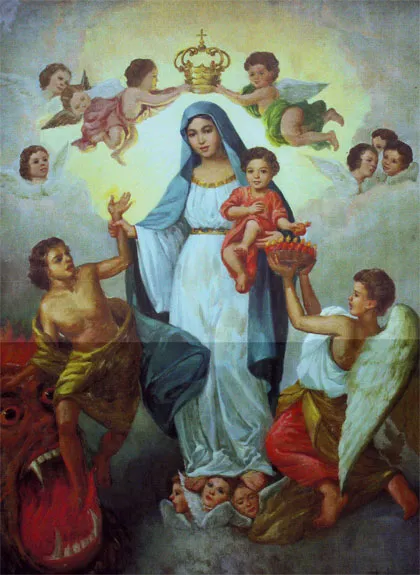
Feast Day - 15th August
The feast of Our Lady of Light is celebrated on 15 August every year which is also the day of Indian independence and hence a national holiday. The day is also as the feast of Assumption of Mary. The feast is celebrated with a grand mass and car procession.
Mass Time
Sundays
- 6:00 am
- 9:00 am
- 6:00 pm
Church Visiting Time
Every Days : 6:00 am to 9:00 pm
Contact Info
156, Luz Church Road,
CIT Colony, Mylapore, Chennai,
Tamil Nadu – 600004, India.
Phone No.
Tel : +91 44 2499 2568
Accommodations
How to reach the Shrine
Chennai International Airport in Airport Road, Meenambakkam, Chennai, Tamil Nadu, India is the nearby airport to the Shrine.
Chennai Central Railway Station in Chennai, Tamil Nadu is the nearby Train Station to the Shrine.

